Survival Skills-Online Survival Guide
Your online survival kits.
Tuesday, May 27, 2014
Godaddy Coupon Code: SPECIAL OFFER! SAVE 50%* Off Hosting Plans With Fr...
Godaddy Coupon Code: SPECIAL OFFER! SAVE 50%* Off Hosting Plans With Fr...: *50% off regular list price for Hosting plan purchase. Cannot be used in conjunction with any other offer, sale, discount, or promotion. A...
Wednesday, July 6, 2011
Distress signals-Part 3
| Fire: Smoke-Flame A group of three (3) lights spaced apart by 30 meters and placed in a triangle is an international signal of distress. You fire up your tripod on a 2 meter high that you will do a basic log green forty centimeters of soil. Your stake will be mounted on the platform and everything is covered with evergreen boughs to protect from the elements. As soon as you hear the engine noise of a plane you light your fire, if it is daylight you leave the tree on top of the smoke will attract attention. If one is at night you remove the tree for the flame to do the same work. Written messages You have used the system when you have to leave to try to find yourself your way. You write the date, the time when you left, you will follow the direction that the number of people with you and their physical condition. If we were to find your campsite before you would know in which direction the research conducted. Also you score your track with the track marks that facilitate research. Take care to place your message in a container or place to weatherproof. | 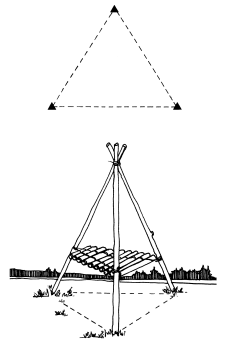 |
Distress Signals-Part 2
 The pyrotechnics
The pyrotechnicsThe pyrotechnics are sold in several formats on the market. Some are adopted to be launched from a gun, others come with their own pitcher.These rockets are orange and amounts to more than one hundred meters. We put these pieces depending when you hear the sound of a jet engine so that it can see us. The colors and shadows every garment color fluorescent or brightly colored shake at the end of a pole or above the vegetation will attract attention.It will create shadows on a plain building or clearing stone walls, wood or snow. This technique is used more in winter on a frozen river or on a plain. The body signals These signals will allow you to communicate with the rescue team when you have been spotted.
 We take it with you |  Do not try to land |  All is well, do not wait | ||
 Yes |  Not |  Need help | ||
 Radio Operation |  Drop your message |  Can be immediately | ||
 Landing point |  Require medical attention (urgent) | |||
Distress signals-Part 1
One of the concerns of people in a survival situation is to be spotted.To establish contact with rescue teams and get their attention you can use the following means:
Any light source can do the job: light, flashlight, mirror heliograph. | Sound signals is not here that you're tired to shout to the four winds. If you think someone may be to carry voice, you can try to communicate by sound, otherwise use the content whistle to send an SOS on a regular basis. Take three shots with a firearm also means that someone is in danger. 2 shots is usually the answer to such a signal. Signals-aircraft surface to air signals are an international code that will allow you to send a message to an air rescue team. In order to be visible symbols must contrast with the environment. Winter will be used dark wood and we will use the shadow play, while the summer we will use wood stripped of bark and light-colored clothing.Signs must be large to be seen from the air, they must be at least twelve feet long. |
 Serious injury, need a doctor |  Need medication |  Impossible to advance |
 Need water and food |  Need map and compass |  Indicate the direction to take |
 I take that direction |  Place to land |  All is well |
 Not |  Yes |  Message not understood |
Advanced Shelters
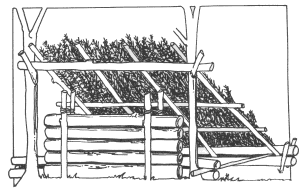 | 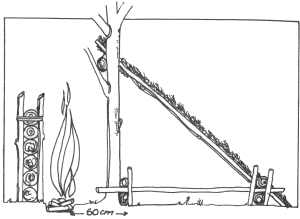 | |
|
|
Shelters
| The shelter used to protect against bad weather, rain, cold, snow. We must choose a high ground with good drainage at the bottom of a valley the water layer builds up and will be in our fleet, too close to a heavy rain during a vintage that will produce the same effect. We choose flat without too much root for a good sleep. The orientation is important, the door should be located to the south or southwest to be protected from prevailing winds. Preferably the wind should hit obliquely behind the shelter to ensure good ventilation and away and fire. The majority of shelters are made of survival, in part, conifer branches, please respect for nature use this material only when necessary. For the years, straw and canvas are much the case, the mattress too. Good conifer litter should be 20 cm thick. | ||||||
| The types of shelters The type of shelter you build will depend on the food and energy you have. The first night as a makeshift shelter under a tree or in a boat should do the trick. If the backup fail and you have the energy you can begin construction of a shelter shed type the following morning. | 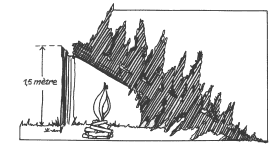 | Shelter tree cut Easy to make, you just have to find a particular conifer provided. Reverses the tree without cutting it completely in one meter above the ground.Identifies branches inside.Make yourself a bed of boughs. This shelter protects a lot of rain, but remember that this is a temporary shelter. | ||||
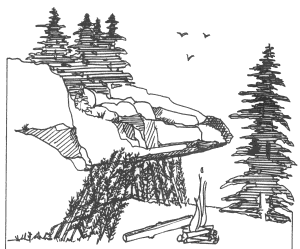 | 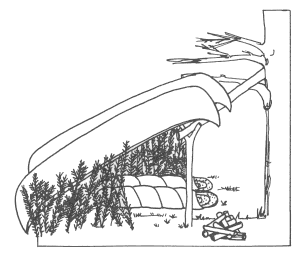 | |
| Overhanging rock search a rocky escarpment overlooking the shelter and complete with evergreen boughs. It is not advisable to take shelter in a cave, it can be inhabited by animals, very wet and you could t'intoxiquer with carbon monoxide given off by a fire. | On a boat Take forked branches to maintain high and the boat and allow ventilation. Complete all with fir branches. |
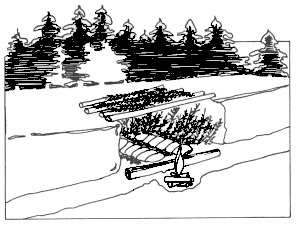 | 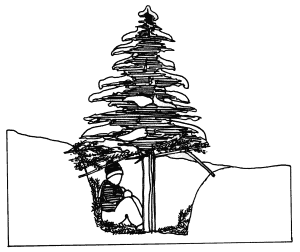 | |
| Hole dug in the snow Dig a hole in the snow to the ground, if possible, to prevent the fire down. Doing a roof of logs you covered with evergreen boughs. Covers the walls and floor of evergreen boughs. | On a conifer Mal taken away the easiest to achieve is a hole under the branches of a conifer. Dig the snow to the ground. Covers the walls, floor and roof of the shelter with branches of conifer. |
How to get water ?
| Water is the second important element in a state of survival. If we just spend several days without food, we do not spend more than a day without water, our body becomes dehydrated. Summer and winter, look for the running waters of streams and rivers flowing into the valleys. There are drinking water in all regions where the population is sparse and there are no places where water is contaminated enough to cause death. The contamination usually occurs in the vicinity of towns and villages, where one rarely used survival techniques. | ||||||
If we do not find running water, here are some ways that can be used to purify water:
| 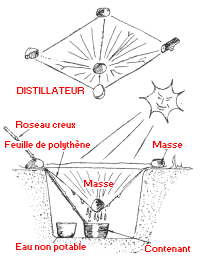 | |||||
Subscribe to:
Posts (Atom)